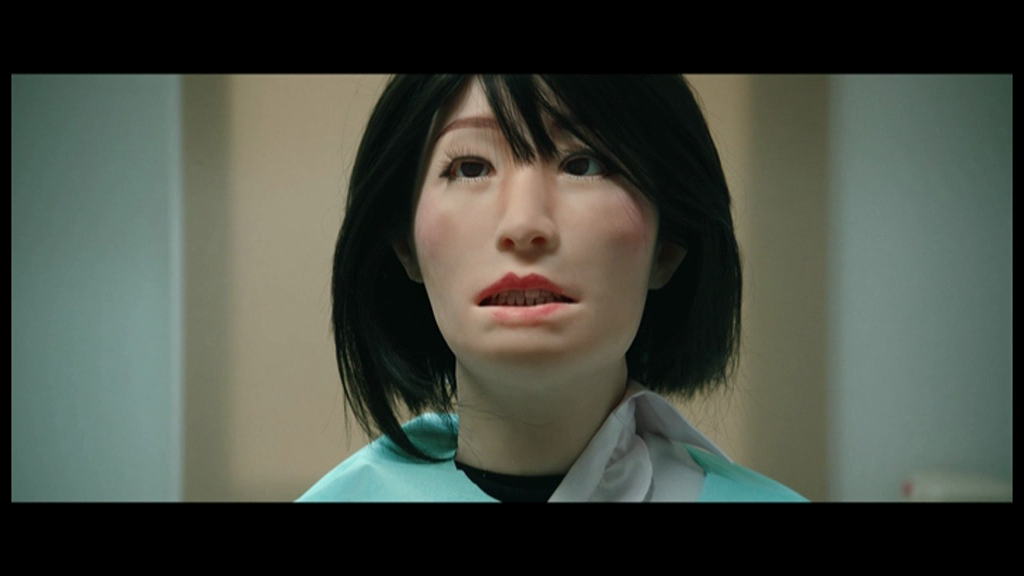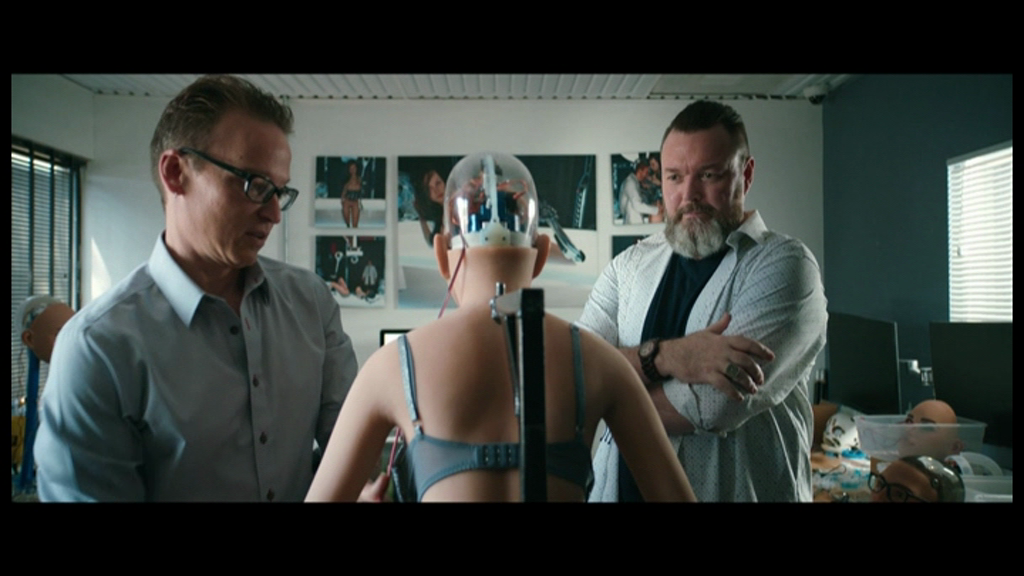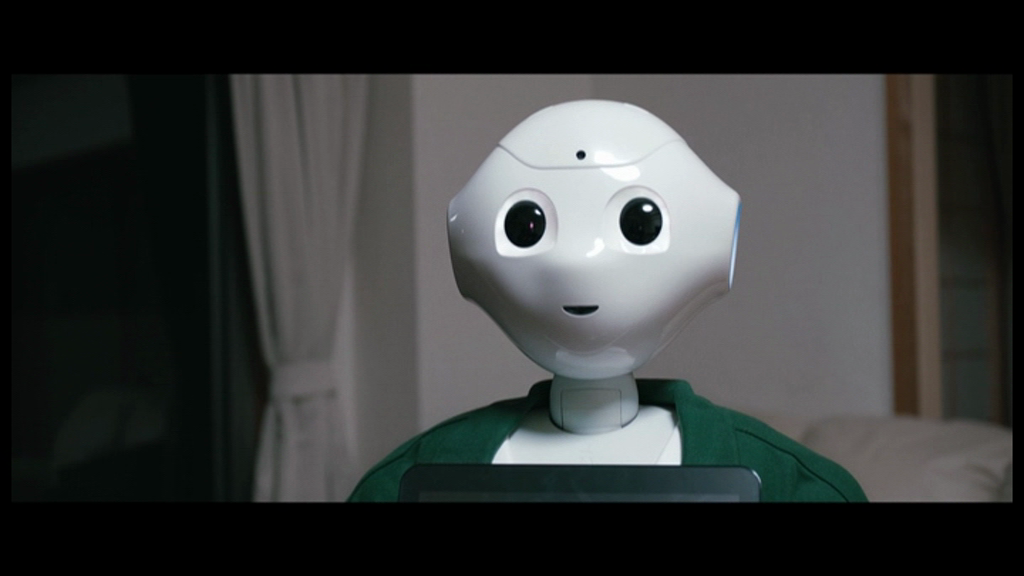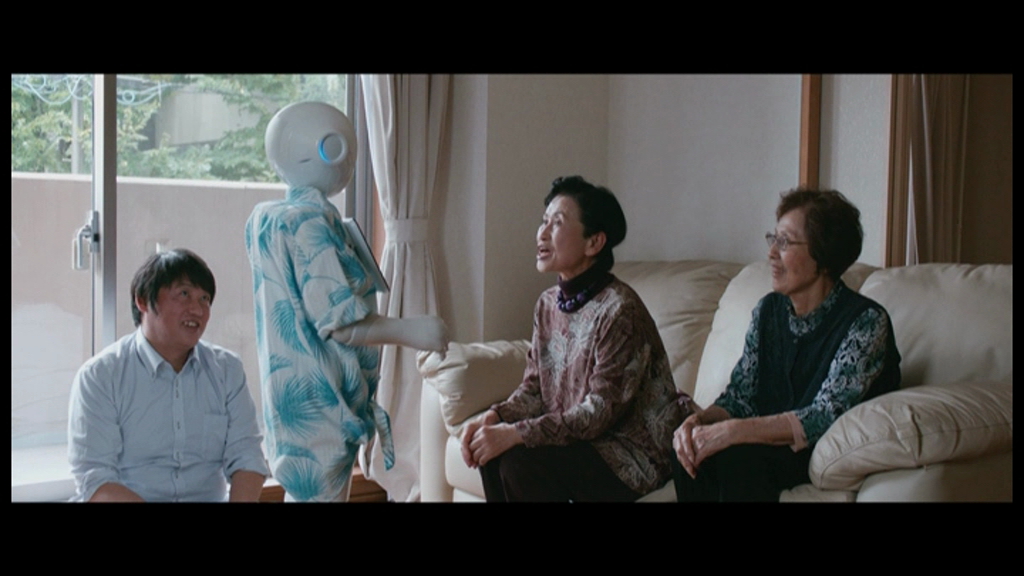Kategorie: Course material in English
"Hi, AI!" – Worksheets
Three exercises related to the film "Hi, AI" for the subjects German, English, Ethics, Social Studies, Politics, Computer Science, from 9th grade.
Exercise 1: Introduction to the Film "Hi, AI!"
Subjects: German, English, Ethics, Social Studies, Politics, Computer Science from 9th grade
Before the Screening:
a) Look at the following screenshots from the Zum Inhalt: documentary film Zum Filmarchiv: "Hi, AI". Describe as exactly as you can what the Zum Inhalt: camera angles show and imagine what the theme of the film might be.
Hi, AI, Szenenfoto (© Rise And Shine Cinema)
Hi, AI, Szenenfoto (© Rise And Shine Cinema)
Hi, AI, Szenenfoto (© Rise And Shine Cinema)
b) Describe the effects the three robots have on you. Select the most expressive attributes you can think of.
c) Humanoid robots are usually constructed for a specific purpose. Look at the following screenshots and consider the Zum Inhalt: locations and the Zum Inhalt: mise-en-scene to analyze the robots’ places of use.
Hi, AI, Szenenfoto (© Rise And Shine Cinema)
Hi, AI, Szenenfoto (© Rise And Shine Cinema)
Hi, AI, Szenenfoto (© Rise And Shine Cinema)
d) The title of the documentary film is "Hi, AI". Are you already familiar with the abbreviation AI? If so, consider where you might encounter it in your everyday lives.
e) Compare the results of your deliberations with regard to definition and use with the bpb article "Zum externen Inhalt: Was ist künstliche Intelligenz – was kann sie leisten? (öffnet im neuen Tab)". Use the Zum externen Inhalt: scanning method (öffnet im neuen Tab).
During the Screening:
f) Split into groups and pay attention to what you learn about the relationships between Sakurai and Pepper and Chuck and Harmony. Analyze the effects of the cinematic means (for example, Zum Inhalt: color and , Zum Inhalt: music and Zum Inhalt: picture composition), used by the director Isabella Willinger.
After the Screening:
g) Compare with the results from exercise f). Discuss what you found particularly surprising or moving. Then discuss whether you think it works to go without an explanatory Zum Inhalt: voice-over. Provide reasons for your verdict.
h) Did your impression of robots change during the screening (compared to exercise b)? Read the definition of Zum externen Inhalt: Uncanny Valley (öffnet im neuen Tab) and discuss the extent to which this was confirmed by the viewing of "Hi, AI".
i) Split up into small groups. Based on "Hi, AI", discuss the opportunities and obstacles involved in the use of artificial intelligence. Then make a podcast or a video blog, in which you present these chances and risks and illustrate how, for example, the labor market or social interactions might change due to the use of artificial intelligence.
Note: Make sure that you use standard terminology and support your arguments with examples or explanations. The podcast or video blog should be no longer than 4:30 minutes.
j) Present the results of your work and give each other feedback based on objective criteria.
Exercise 2: From artificial intelligence to artificial consciousness
Subjects: German, English, Ethics, Computer Science from 10th grade
a) Split up into three groups (A, B and C). Each group analyzes a Zum Inhalt: scene in which there is communication between human being and humanoid robot. Pay attention to
• how sentences are constructed
• what impression is caused by the flow of the language
• the extent to which the communication is Zum externen Inhalt: symmetrical or complementary (öffnet im neuen Tab)
• the non-verbal elements that form part of the communication
• what you learn about the level on which the relationship between those involved takes place
Evaluate the extent to which you find the communication successful. Pay attention to how the cinematic means used (for example, Zum Inhalt: camera angles, Zum Inhalt: perspectives and Zum Inhalt: picture composition) amplify this effect.
Group A: 00:16:54-00:18:14
Group B: 00:18:15-00:21:04
Group C: 00:25:35-00:29:40
b) Show your scenes to the other groups and present the results of your work.
c) Discuss what aspect the programmers paid special to when developing the three humanoid robots. Compare the results of your work with the bpb article on Zum externen Inhalt: machine ethics (öffnet im neuen Tab).
d) Engage in conjecture and complete the table by making crosses.
| Statement | True | False |
|---|---|---|
| Humans develop feelings for robots, although they know how the machines work. | ||
| A US Army colonel stopped an experiment with a robot out of empathy, because the robot damaged itself as part of the test. | ||
| Household robots do not look like humans. For this reason, they cannot trigger feelings. | ||
| Humans have no inhibitions about destroying robots. | ||
| The inhibitions are greater when the robot has a name. | ||
| Robots cannot help humans to understand each other better. |
e) Watch the following Zum externen Inhalt: Ted Talk (öffnet im neuen Tab) by the US scientist Kate Darling and check the results of your work.
f) The documentary film "Hi, AI" depicts humanoid robots that are supposed to help human beings. Other than human or animals, they have no official rights. Name the aspect addressed in the film which could change this.
g) Which rights would then have to be granted to robots, i.e. an artificial intelligence? Discuss with a partner.
h) Imagine you are writing a Zum Inhalt: science fiction-film with your partner, in which these robot rights are portrayed. Compose a scene referring to a topic in "Hi, AI" (for example, robot-to-human interaction or robots in the world of work). In this scene, demonstrate that the robot has certain rights, without explicitly naming them.
i) Present your scenes to class. The other groups must then name the rights alluded to in the respective scene.
Exercise 3: The different forms of artificial intelligence
Subjects: German, English, Computer Science from 9th grade
a) Watch the following scene from "Hi, AI" and then summarize what is understood by the term control problem.
Timecode: 00:21:43-00:23:53
b) Professor Oliver Brendel explains in an Zum externen Inhalt: interview with kinofenster.de (öffnet im neuen Tab) that there are different kinds of artificial intelligence. The following exercise is about these different forms. Decide whether you wish to adopt a film-practical or film-analytical approach.
Film-Analytical:
c) Read the background article by Zum externen Inhalt: Jan-Philipp Kohlmann (öffnet im neuen Tab) and Zum externen Inhalt: Andreas Busche (öffnet im neuen Tab) on kinofenster.de.
d) Assign the following films to small groups:
Group A:
Group B: "Ex Machina"
Group C: Zum Filmarchiv: "2001 – A Space Odyssee"
Each group draws up a presentation on the following aspects of the respective film:
• general information on the film (year and country of production, Zum externen Inhalt: genre (öffnet im neuen Tab), director, Zum Inhalt: screenplay etc.)
• subject matter
• type of artificial intelligence
• cinematic means that characterize the film in general and are used to portray artificial intelligence
• to what extent the type of artificial intelligence still represents science fiction or has become, in modified form, a part of our everyday lives
Note: Select striking scenes for your presentation.
Film-Practical:
e) Split up into small groups. Each group agrees on a type of artificial intelligence that forms a part of our day-to-day lives for a Zum Inhalt: documentary film project. If appropriate, refer to the results of exercise 1e).
f) Consider how you wish to portray the interaction between human being and machine. Decide which shooting locations you wish to use and which characters appear. Plan a Zum Inhalt: film sequence. Draw a Zum externen Inhalt: storyboard (öffnet im neuen Tab) that illustrates the planned Zum Inhalt: camera angles and Zum Inhalt: perspectives.
Optional:
g) Produce the planned sequence. Choose a Zum externen Inhalt: free editing software (öffnet im neuen Tab)..
Important: Sequences containing pictures or sounds to which you do not have the rights may not be uploaded on the Internet or shared on social media networks.
All Groups:
h) Present the results of your work and give each other feedback based on objective criteria.
i) "Science fiction tells stories that have never happened and never will", wrote Dietmar Dath in his science fiction treatise Niegeschichte , published in 2019. Discuss the extent to which this applies to the three films. Are elements of the films to be found in modern day-to-day life?





